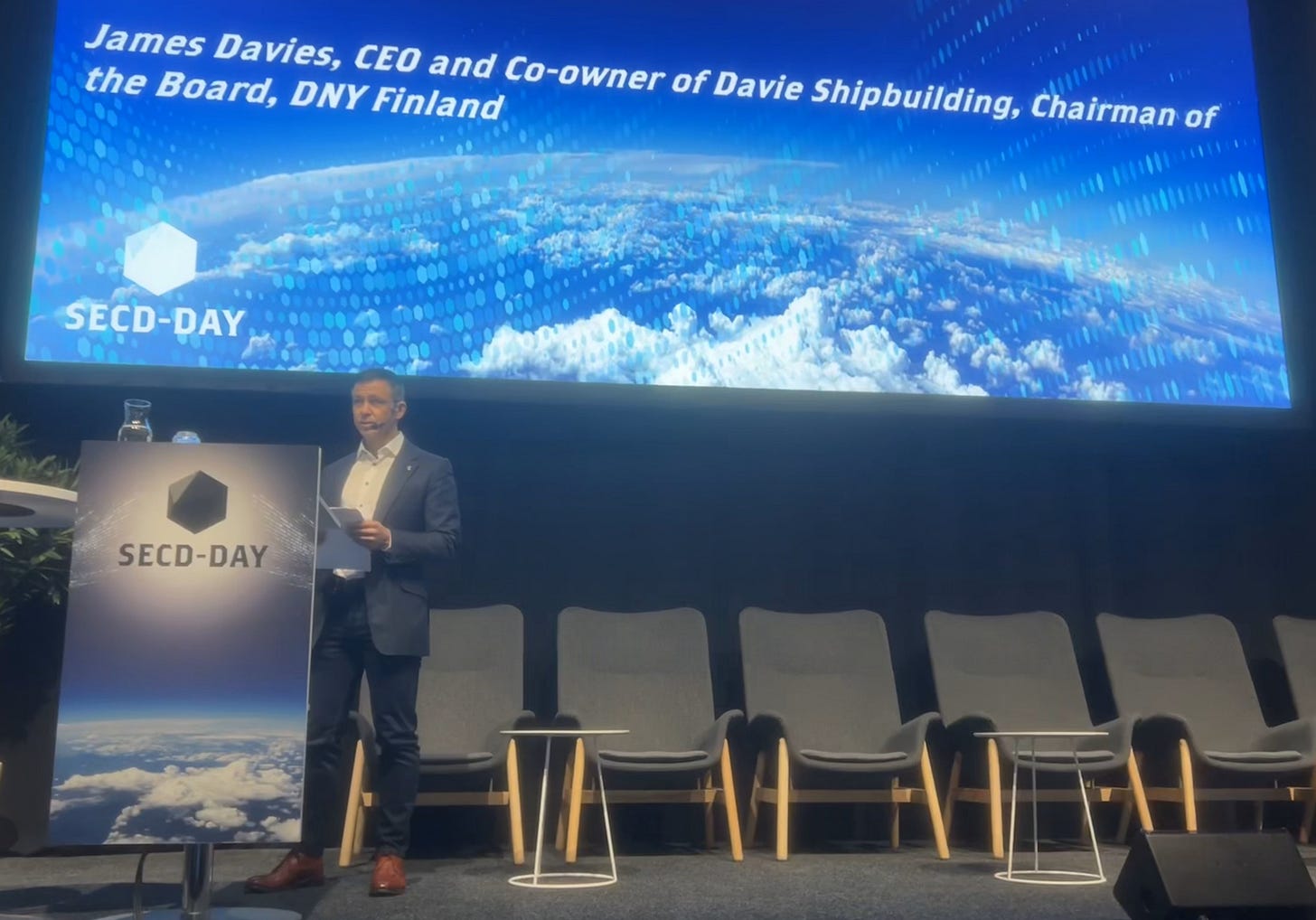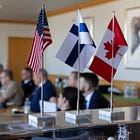Canada's Davie Planning Major Investment in U.S. Shipyard
In a recent speech, Davie's CEO stressed the important role of industrial cooperation, including a planned investment in a U.S. shipyard, in addressing the strategic challenges faced in the Arctic.
Davie and Icebreaking
Davie, which celebrates its 200th year in 2025, describes itself as “Canada’s premier shipbuilder and a global leader in the delivery of specialist, mission-critical vessels to government and commercial customers.” During that 200-year history, Davie has built all kinds of ships including naval combatants, merchant vessels, and icebreakers.
Inocea, which acquired Davie in 2012, brought in significant private investment to revitalize Davie’s Quebec shipyard. A key player in Canada’s National Shipbuilding Strategy, Davie established its National Icebreaking Center in 2020 and is currently building seven icebreakers (one heavy and six medium) for the Canadian Coast Guard plus two ice-capable ferries.
To bolster its expertise in icebreaker construction, Davie purchased Helsinki Shipyard from Russian owners in November of 2023.
Davie’s CEO and co-owner through Inocea, James Davies, announced in July of 2024 that Davie planned to make “a significant, long-term commitment to the American shipbuilding industry.”
James reiterated his intention to invest in the U.S. shipbuilding industry during a January 29th speech in Helsinki, Finland.
The speech, given at a defense exhibition hosted by the Association of Finnish Defense and Aerospace Industries, was titled “The Role of Industry in Strengthening International Defense and Security Relations.” The speech is about 15 minutes long and is worth a listen. My analysis follows the audio link.
Please forgive the sound quality, as this was my first attempt to record something live for this blog. I did run it through some software to reduce the background noise, but the resulting audio sounded quite unnatural, so I’m leaving it as it was.
The Importance of the United States
In his speech, Mr. Davies stressed the importance of transatlantic cooperation, especially the key role played by the U.S.:
For sure, transatlantic cooperation is not a luxury. It is a strategic necessity. The ancient saying, Si vis pacem, para bellum- if you want peace, prepare for war- underscores the absolute need for readiness- not just militarily, but also economically and industrially.
At Davie, we build trust through our actions, so let me briefly share who we are and what we do. Davie has been at the heart of Canada's shipbuilding industry for exactly 200 years. We bought Davie now more than 12 years ago. Our recent acquisition of Helsinki Shipyard in 2023 returned a very special capability from Russian hands. And together we must form an effective transatlantic industrial bridge, uniting Canada, Finland, and frankly soon the United States. At the industry level.
Davie’s Planned Investment in the U.S.
I later asked Paul Barrett, Davie’s CCO (Chief Communications Officer) for more information about Davie’s planned investment in a U.S. Shipyard. Here is his response:
We see major opportunities in an American shipbuilding renaissance, supporting the delivery of icebreakers, and other specialized vessels. We are in advanced negotiations to acquire an established U.S. shipbuilder. If successful, we plan to invest – just as we are in Quebec. Our C$800M+ facility upgrade there is underway and independent assessments confirm it will make us the most advanced and flexible facility for specialised ships in North America.
This is important news. But it is worth paying attention to the rest of the speech. Here are some of the other items that Mr. Davies addressed:
The ICE Pact and the role of government:
According to Mr. Davies, the ICE Pact1- a government-to-government agreement between the United States, Canada, and Finland- has a role to play in reducing barriers to industrial cooperation:
The mission then for the ICE Pact is clear. Deliver advanced, ice capable vessels that safeguard sovereignty, strengthen alliances, and secure economic interests. And we have to do that better, faster and cheaper. The protracted post cold-war development and procurement cycles, frankly have no place in this new competitive environment. Time is of the essence, resources are limited. Not just money- people, manpower, focus.
In …many cases, {government programs must} swap perfection for good enough. What's the cost of perfection? Well, it never finishes because it's never perfect. There's always something else. Consequently, the cost of perfection is exponential and ultimately infinite. And the opportunity cost that comes with the delay- fatal.
Let's get throughput back up. Efficiency and ultimately efficacy comes with practice. Let's not let bureaucracy stand in the way either. Peace dividend rules need to be flexed appropriately. So the need for new forms of corporation could not be more urgent. I believe that governments can help by considering easing barriers to foster innovation.
The ICE Pact in its current form is non-binding and contains no concrete proposals. Some recent comments by President Trump suggest that cooperation concerning icebreaker procurement with the current Canadian government would be, at best, challenging. But if the ICE pact helps the three signatories to reduce barriers to industrial cooperation, it will have done its part. As according to Mr. Davies, while government cooperation is necessary, it is not sufficient.
The Role of Industry
Industry itself can play a larger role. As Mr. Davies noted:
Davie’s planned extension into the U.S. is not just about geography. It's about supporting a western renaissance in shipbuilding in the biggest single market that, frankly, needs it. Needs it badly. And we can help achieve this by being a conduit.
Because of Helsinki shipyard, we're part of this ecosystem. And our Finnish knowhow means we can build the ships that are needed. With unparalleled efficiency. And at speed, as I mentioned, in as little as 36 months. Show me another shipbuilder who can build a prototype, highly complex, difficult to build asset, like an icebreaker, in 36 months. I do not know of any….
But we actors, the private sector, have to be allowed to lead in creating sustainable growth. And this requires investment. So the onus is also on us to recruit and nurture, mentor the best talent, to cooperate between ourselves beyond the risk of perception of a piece of a pie, a piece of a market. There's too much to do, trust me.
A Refreshing Perspective
In my article from last year, Introducing the ICE Pact, I compared the social media announcements made by some of the key players to the PACTs initial announcement.
While Bollinger was busy releasing messages heralding Pascagoula, MS as the new “icebreaker capital of the world,” Mr. Davies was writing about the strategic importance of rebuilding western shipbuilding expertise and capacity.
He continued his trend of seriously discussing the issues in this speech, highlighting the importance of the Arctic region:
Almost wherever we look on the world map today, it is blighted by geopolitical tension, conflict, and competition for resources. Perhaps nowhere is this more evident than in the Arctic, a region where geostrategic and economic interests increasingly intersect, an Arctic cold rush is underway. Our adversaries are for the first time sharing and advancing their Arctic capabilities, and they are doing this at an increasingly alarming pace. It demands a decisive and united response. That response should have started yesterday. The rapid expansion of ice capable fleets by competitors from nuclear powered icebreakers, ice breaking warships, and science vessels that, well, frankly double in a surveillance role, demonstrates ambitions that directly threaten the rules-based order of yesterday and the vital interests of the Western alliance.
And no Arctic strategy can succeed without icebreakers:
Let me put it like this: if defense and sovereignty require a physical presence, and that presence is only possible with the right assets, and in the arctic icebreakers are those assets- the proverbial fences that ensure good neighbors- and those vessels take a minimum, even here in Finland, in Helsinki, of 36 months, then when are we going to act in order to have the scale to have the presence that is necessary to defend our collective sovereignty?
When are we going to act? A very good question.
Let’s pray that its soon.
Thoughts and Comments
I write these articles to advocate for more ships for the U.S. I’ve focused on icebreaker, because it is what I know- and because the solution seems so obvious. It’s no secret that I believe the fastest and best way for the U.S. Coast Guard to acquire the icebreakers that it needs is to look overseas.
James Davies seems to see the same basic need- that collectively, the West needs more icebreakers to meet the strategic challenge posed by increased Russian and Chinese cooperation in the Arctic.
Unlike many, he seems to be taking direct action to make that happen. I’m looking forward to hearing more about Davie’s investment in the U.S., as the prospect of long-term icebreaker production in the U.S. may make it easier for the U.S. Coast Guard to get the foreign-built ships that it needed years ago.
As I wrote this article, news came out that Senators Mike Lee (R-UT) and John Curtis (R-UT) have proposed two bills, the Ensuring Naval Readiness Act and Ensuring Coast Guard Readiness Act that would make it easier for the U.S. Navy and U.S. Coast Guard to acquire vessels built overseas in allied nations. Additionally, the Department of Government Efficiency is poised to take a look at government shipbuilding.
Davie is working to make things happen. I’ll keep watching and reporting on their progress.
All the Best,
PGR









So the big question is which American shipyard will they pursue? Hanwha just bought Philly. NASSCO would make sense if they want to build icebreakers, but General Dynamics would need to be agreeable to selling. I don’t see BIW or Ingalls as prime targets.